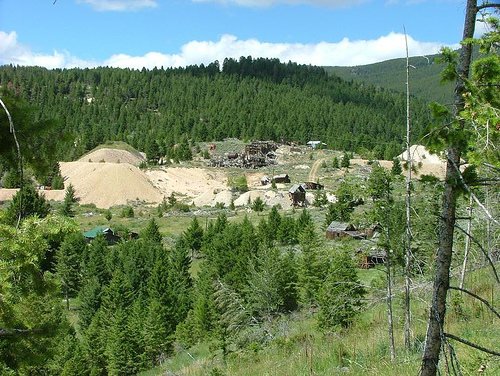

Location: Jefferson County, Montana Map
Found: 1872
Abandoned: 1970s
Elkhorn, Montana was constructed on a site of a silver mining
camp after a large deposit of precious metal was discovered nearby.
Elkhorn counted 2500 residents with several churches, hotels, 14
saloons, lodge halls, several grocery stores and a post office. By
the turn of the 20th century mines were closed after producing $14
million in gold and silver. Local cemetery of Elkhorn tell yet
another reason for city's demise. Several epidemic swiped through
the area taking a toll on the youngest residents of the town.
Primitive conditions allowed such disease like small pox, influenza,
typhoid, scarlet fever, yellow fever and diphtheria in late 1888 and
early 1889 to lay havoc on the local population. Today only 50
structures remain on an original location of Elkhorn Ghost Town.
Most of them are privately owned.
Elkhorn is in eastern
Jefferson County on the south side of the Elkhorn Mountains, in the
valley of Elkhorn Creek. It can only be reached through its
neighboring town, Boulder, by taking the I-15 Boulder exit,
continuing 7 miles (11 km) southeast on Montana Highway 69, then 11
miles (18 km) north on county graveled road. According to the U.S.
Census Bureau, the Elkhorn CDP has an area of 6.8 square miles (17.5
km2), all of it land.
While very few standing buildings
remain of the original Elkhorn, a number of cabins have been
reoccupied and refurbished. In 2010, there were 10 inhabitants.
Silver lodes, described by geologists as supergene
enrichments, were first discovered in the Elkhorn Mountains by Peter
Wys, a Swiss immigrant. Six years later, Anton Holterm, a pioneering
capitalist from Montana, began developing the mine. More than $14
million worth of silver was mined from the mine. In 1890, the Sherman
Silver Purchase Act was passed, creating a huge demand for Elkhorn
silver.
During its heyday, Elkhorn boasted a population of 2,500,
a school, hotel, church, warehouses, saloons and also brothels. As with
other mining towns, Elkhorn was populated mainly by married European
immigrants. In 1893, Fraternity Hall was built for social activities and
still stands today as one of the best preserved buildings in Elkhorn.
In the years following the silver boom, Elkhorn's prosperity began
to decline. A diphtheria epidemic also hit the city, resulting in a high
death toll, especially among children. Shortly thereafter, the rail
service ceased to operate in Elkhorn and only a small number of
inhabitants remained in the city.